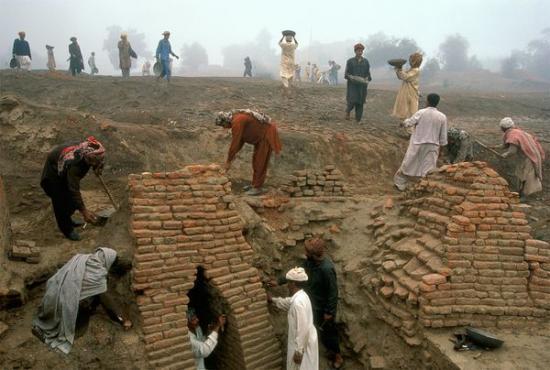Early cities spurred evolution of immune system ?
“Amazing” DNQ results show benefits of ancient urbanization, study says.
Matt Kaplan
Source : http://news.nationalgeographic.com/news/2010/11/101108-cities-immune-system-tuberculosis-tb-evolution-dna-genetics-science/

Workers excavate a culvert at the circa-2725 B.C. site of the Harappa settlement in Pakistan (file photo).
Photograph by Randy Olson, National Geographic
As in cities today, the earliest towns helped expose their inhabitants to inordinate opportunities for infection—and today their descendants are stronger for it, a new study says.
"If cities increase the amount of disease people are exposed to, shouldn't they also, over time, make them natural places for disease resistance to evolve?" asked study co-author Mark Thomas, a biologist at University College London.
It's basic evolutionary theory: People who survive infection stand a better chance of having children and passing along disease-resistant genes. So groups from regions where urbanization has existed for thousands of years should be more disease resistant.
The trick was finding proof.
To do so, study co-author Ian Barnes, a molecular paleobiologist at University College London, screened DNA samples from 17 groups long associated with particular regions of Europe, Asia, and Africa—for example Anatolian Turks and the southern Sudanese.
Barnes analyzed the DNA samples for a gene associated with resistance to tuberculosis (TB) and suspected of being associated with resistance to leprosy as well as to leishmaniasis, a reaction to sand fly bites, and to Kawasaki disease, a childhood ailment that involves inflamed blood vessels and can lead to heart disease.
At the same time, the team studied archaeological and historical data to work out where the earliest cities were on these regions. For example, in Anatolia the Çatal Hüyük settlement is roughly 8,000 years old, while in southern Sudan, the city of Juba (map) isn't even a hundred.
In areas of ancient urbanization, it turned out, "we found very high frequency" for the TB-resistance gene, study co-author Thomas said. But, for example, "the Saami people from northern Scandinavia and the Malawi people from Africa, who have little history of urban living, did not have this frequency.
"We were utterly amazed by how strongly the statistics supported what we were seeing," he added. "When you look for things like this in evolutionary history, there's so much over the years that can mess up your data."
The Price of Protection
"It's a good study and the findings make a lot of sense," said epidemiologist Andrew Read. But it also raises more questions.
"That it took the rise of disease-ridden cities to cause this resistant gene to become common suggests to me that there must be a cost to having it—or else it would have been common in the first place," said Read, of Pennsylvania State University, who wasn't involved in the new study.
Perhaps, he said, the resistant gene causes immune systems to overreact—and attack the body when it's exposed to harmless things like peanuts and pollen—making people more vulnerable to allergies and arthritis, for example.
And while it may be small consolation to the allergic and arthritic, having those disorders, Read said, might be a small price to pay for avoiding death by tuberculosis.